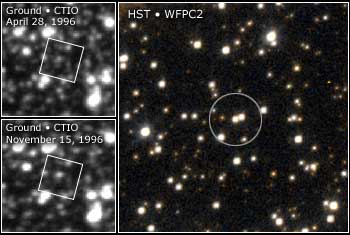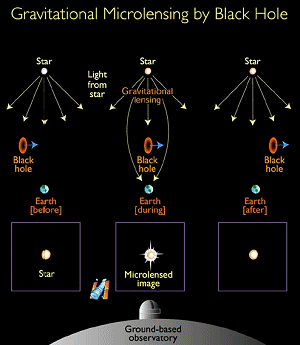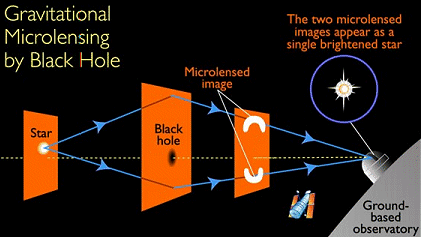

|
[Left] Two images of a crowded starfield as seen through a ground-based telescope show the subtle brightening of a star due to the effect of gravitational microlensing, where an invisible but massive foreground object passes in front of the star and amplifies its light. The dark lensing object is estimated to be a six-solar-mass black hole that is drifting alone among the stars. Credit: NOAO, Cerro Tololo Inter-American Observatory |
[Right] A NASA Hubble Space Telescope image of the same field clearly resolves the lensed star (at center) and yields its true brightness. The Hubble observation was needed because the ground-based images do not tell how bright the lensed star actually was before (or after) it was lensed. The star fields where microlensing events are observed are so crowded with stars that the lensed star images are often blended together with images of unlensed stars. But with the Hubble images, astronomers can identify the lensed star and determine its normal brightness. The Hubble images were taken on June 15, 1999. Credit: NASA and Dave Bennett (University of Notre Dame, Indiana) |
STScI-PR00-03; January 13, 2000
Two international teams of astronomers using NASA's Hubble Space Telescope and ground-based telescopes in Australia and Chile have discovered the first examples of isolated stellar-mass black holes adrift among the stars in our Galaxy.
All previously known stellar black holes have been found in orbit around normal stars, with their presence determined by their effect on the companion star. The two isolated black holes were detected indirectly by the way their extreme gravity bends the light of a more distant star behind them.
"These results suggest that black holes are common and that many massive but normal stars may end their lives as black holes instead of neutron stars", said David Bennett of the University of Notre Dame, South Bend, Ind. Bennett presented his team's results today in Atlanta at the 195th meeting of the American Astronomical Society.
The findings also suggest that stellar-mass black holes do not require some sort of interaction in a double-star system to form but may also be produced in the collapse of isolated massive stars, as has long been proposed by stellar theorists.

The black hole's gravity acts like a powerful lens, bending the light of a background star so that it appears as two separate images when the black hole slowly drifts in front of it. The bending angle is about 100 times smaller than the angular resolution of Hubble, so the two distorted images of the background star cannot be separated, even in high-resolution Hubble images.
However, the black hole's gravity also magnifies these stellar images, causing them to brighten as the black hole passes in front. Bennett's team was searching for these passages, called gravitational microlensing events.
Careful analysis of the two events reveals that the lensing objects are each approximately six times the mass of the Sun.
If the objects were ordinary stars with this mass they would be bright enough to outshine the more distant background source star.
The masses are also too large to be white dwarfs or neutron stars.
This leaves a black hole as the best explanation.
This microlensing detection technique, combined with Hubble's extraordinary resolution to pinpoint the lensed star,
opens the possibility for searching for lone black holes and assessing whether they contribute to the galaxy's long-sought "dark matter".
These microlensing events were discovered in 1996 and 1998 by the Massive Compact Halo Object (MACHO) collaboration with the National Science Foundation, using the 1.3-meter telescope at the Mount Stromlo Observatory in Canberra, Australia, while the magnification was still increasing. The prompt discovery and announcement of these events enabled precise follow-up observations by the Global Microlensing Alert Network (GMAN) from the 0.9-meter telescope at Cerro Tololo Inter-American Observatory (CTIO) and by the Microlensing Planet Search (MPS) project, using the 1.9-meter telescope at Mount Stromlo.
The MACHO team surveys tens of millions of stars in the direction of the center of our Galaxy, where the starfield is very crowded, increasing the chances for seeing rare gravitational microlensing events. The two events were also of exceptionally long duration, lasting 800 and 500 days respectively, which suggests that the lensing objects have a high mass.

Follow-up observations were done with Hubble on June 15 '99 to clearly identify the lensed star for the first event
and make a precise measurement of its brightness after the lensing event.
The Hubble frame indicates that the lensed star was blended with two neighboring stars of similar brightness
that could not be separated in the poorer-resolution, ground-based images.
Hubble's identification of the lensed star allowed for an accurate estimate of the mass of the black hole.
The 1998 event was brighter, and modeling of the ground-based measurements enabled astronomers to determine the brightness of the lensed star, but this determination awaits confirmation with future Hubble images.
There have been more than 300 instances of gravitational microlensing seen towards the central regions of our Galaxy to date. The longest duration microlensing events could be caused by either very massive lenses or slow relative motion between the lens and source, but additional information was needed to determine the parameters of the lensing event. This additional information was obtained by the GMAN and MPS groups using the 0.9-meter telescope at CTIO and the 1.9-meter telescope at Mount Stromlo in the form of an asymmetry in the pattern of magnification with time due to the orbital motion of the Earth. This asymmetry is known as the microlensing parallax effect as it is similar to the parallax effect which yields the distances of nearby stars.
For higher-resolution versions of the images in this release, see Lone Black Holes Discovered Adrift in the Galaxy (PR00-03) (at the Web site of the STScI).
For information on Black Holes, link to Black Holes, from the Royal Greenwich Observatory (in ARVAL).
![]() The Space Telescope Science Institute
is operated by the Association of Universities for Research in Astronomy, Inc. (AURA),
The Space Telescope Science Institute
is operated by the Association of Universities for Research in Astronomy, Inc. (AURA),
for NASA, under contract with the
Goddard Space Flight Center, Greenbelt, MD.
The Hubble Space Telescope is a project of international cooperation between NASA and the
European Space Agency (ESA).
Copyright © 1998 The Association of Universities for Research in Astronomy, Inc. All Rights Reserved.
![]() Updated: January 15 '00
Updated: January 15 '00
Best seen with MS Internet Explorer.
Back: ARVAL's Gallery (Lone Black Holes Discovered Adrift in the Galaxy)
Messages: